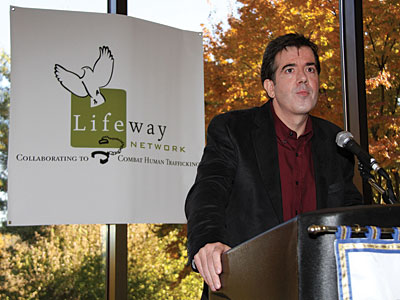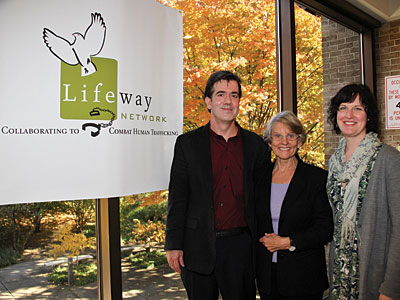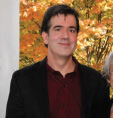Work by Dr. Gregory Maney and His Grad Students Uncovers a Victimized Population
Those who think human trafficking is a crisis only in third world countries may be shocked by the findings of research conducted by Hofstra Sociology Professor and Department Chair Gregory Maney, six of his graduate students, and an advocacy group called LifeWay Network. The unfortunate truth is that extensive trafficking is taking place in the New York City metropolitan area, including on Long Island.

Dr. Greg Maney at the press conference to release the findings of research on human trafficking in the New York metropolitan area.
After hearing from LifeWay Network, Dr. Maney approached some of his Hofstra students about the proposed research project. “I was teaching graduate courses as part of the Master’s Program in Applied Social Research and Public Policy. I asked the students whether they would be interested in this kind of research, and you should have seen their reactions. They were just thrilled to think that they could be working with a coalition that’s dealing with one of the most pressing human rights issues of our time.”
Between May and December of 2010, LifeWay Network staff and board members, Dr. Maney, and the graduate students worked together to design, administer, and analyze surveys and interviews of area private service providers, funding and coordinating agencies, and law enforcement representatives. On November 9, 2011, Hofstra hosted a press conference to release the findings.
Regarding the scope of trafficking, the report estimates that private service providers in the New York City metropolitan area interacted with more than 11,000 trafficking survivors since 2000, and more than 1,600 in 2011 alone.
Dr. Maney commented on the findings, “these figures far exceed official estimates, yet only scratch the surface of the actual number of trafficking victims. Our study does not account for trafficking survivors who managed to escape and immediately left the area, survivors who remain in the area who have yet to interact with private service providers, victims who continue to be held captive, and those who have died while being trafficked. The findings underscore not only the pervasiveness of the problem, but the scope of this tragedy. Every person trafficked has experienced extreme suffering, hardship and injustice.”
New York state, federal, and international laws mandate a wide range of services for trafficking survivors. The report, however, indicates that basic needs of survivors are often not being met. Regarding housing: 86.6 percent of survivors who made contact with private service providers were in need of safe, long-term housing, but only 3.9 percent of clients actually received it. While emergency shelters were more readily available, they were not suitable for survivors because of safety issues, lack of training of the staff, limited services, and limited duration of availability.
High rates of demand for other critical services were also largely unmet, including medical care, telephone services, formal/ general education, and volunteer programs for survivors. Dr. Maney said, “A failure to meet the service needs of survivors increases the likelihood of being re-trafficked, physical and psychological complications, social isolation, substance abuse, poverty, and suicide.”
The report offers other surprising findings. While media coverage often focuses upon sex trafficking, the research indicates that there is also a large amount of other types of labor trafficking in the New York metropolitan area. Private service providers responding to the survey indicated that 21.5 percent of the survivors with whom they have interacted were victims of labor trafficking. An additional 7 percent were victims of a combination of sex and labor trafficking.

There is also a widespread assumption that only women are victims of trafficking. Yet survey respondents indicated that 13.4 percent of the survivors to whom they provided services were men. And in contrast to the emphasis, until recently, upon providing services to foreign-born victims, respondents reported that nearly two-thirds (65.6 percent) of survivors were born in the United States.
Not surprisingly, those that don’t fit the stereotypical image of trafficking victims were less likely to receive services. Survey respondents indicated that the following subgroups of survivors were frequently underserved: male survivors, transgender survivors, domestic born survivors, survivors under the age of 18, and female labor trafficking survivors.
Identifying the victims of human trafficking presents several challenges. Some trafficking victims fear coming forward, while others do not even recognize that they have been trafficked. The authors of the report recommend expanded training on identifying and assisting victims for service providers and law enforcement agencies alike. They also call upon the media to extensively publicize the National Human Trafficking Resource Center hotline and to provide the public with information regarding the indicators of human trafficking (i.e., asking possible victims if they are free to leave their place of work; if they receive all their earnings directly; and if they are able to contact friends and family members).
With the help of the report, LifeWay has established a new housing program for trafficking survivors. The program is only the second of its kind in the area. For Dr. Maney, the outcome demonstrates how research partnerships with community-based organizations can play critical roles in not only raising awareness of serious human rights abuses, but also assisting in the protection and promotion of human rights.
“The participating graduate students and I experienced firsthand the rich insights and transformative potential of research done in partnership with a community-based organization,” said Dr. Maney. Graduate student Nicole Wiktor said of the experience: “The most valuable lesson was that we were able to narrate a story with data that tells the truth and that attempts to make a difference. I think this project is something we can be very proud of. The fact that a housing program was established as a result of it is amazing. This is certainly a cause that has grown close to my heart through our research and the great people that were part of the project.”
New York state, federal, and international laws mandate a wide range of services for trafficking survivors. The report, however, indicates that basic needs of survivors are often not being met. Regarding housing: 86.6 percent of survivors who made contact with private service providers were in need of safe, long-term housing, but only 3.9 percent of clients actually received it. While emergency shelters were more readily available, they were not suitable for survivors because of safety issues, lack of training of the staff, limited services, and limited duration of availability.
High rates of demand for other critical services were also largely unmet, including medical care, telephone services, formal/ general education, and volunteer programs for survivors. Dr. Maney said, “A failure to meet the service needs of survivors increases the likelihood of being re-trafficked, physical and psychological complications, social isolation, substance abuse, poverty, and suicide.”
The report offers other surprising findings. While media coverage often focuses upon sex trafficking, the research indicates that there is also a large amount of other types of labor trafficking in the New York metropolitan area. Private service providers responding to the survey indicated that 21.5 percent of the survivors with whom they have interacted were victims of labor trafficking. An additional 7 percent were victims of a combination of sex and labor trafficking.

(L to r) Dr. Maney; Sister Joan Dawber, executive director of LifeWay Network; and Faith Huckel, executive director of Restore NYC.
Not surprisingly, those that don’t fit the stereotypical image of trafficking victims were less likely to receive services. Survey respondents indicated that the following subgroups of survivors were frequently underserved: male survivors, transgender survivors, domestic born survivors, survivors under the age of 18, and female labor trafficking survivors.
Identifying the victims of human trafficking presents several challenges. Some trafficking victims fear coming forward, while others do not even recognize that they have been trafficked. The authors of the report recommend expanded training on identifying and assisting victims for service providers and law enforcement agencies alike. They also call upon the media to extensively publicize the National Human Trafficking Resource Center hotline and to provide the public with information regarding the indicators of human trafficking (i.e., asking possible victims if they are free to leave their place of work; if they receive all their earnings directly; and if they are able to contact friends and family members).
With the help of the report, LifeWay has established a new housing program for trafficking survivors. The program is only the second of its kind in the area. For Dr. Maney, the outcome demonstrates how research partnerships with community-based organizations can play critical roles in not only raising awareness of serious human rights abuses, but also assisting in the protection and promotion of human rights.
“The participating graduate students and I experienced firsthand the rich insights and transformative potential of research done in partnership with a community-based organization,” said Dr. Maney. Graduate student Nicole Wiktor said of the experience: “The most valuable lesson was that we were able to narrate a story with data that tells the truth and that attempts to make a difference. I think this project is something we can be very proud of. The fact that a housing program was established as a result of it is amazing. This is certainly a cause that has grown close to my heart through our research and the great people that were part of the project.”


0 comments:
Post a Comment